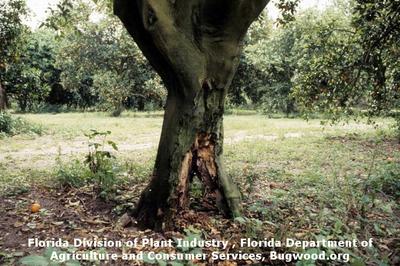Black Shank
Phytophthora nicotianae
Fungus
In a Nutshell
- Leaves show abnormal colors and forms, distortion and curling.
- Necrotic patches appear amidst an extensively chlorotic leaf.
- In trees, the fruits also have an abnormal shape, and their skin is covered by black or brown lesions.
- Extensive mold develop on these lesions and ooze can be seen dripping down.
- Copious gum exudes from lesions on bark (gummosis).
Can also be found in
Symptoms
The symptoms of this disease can be observed at all growth stages of the plant and in all plant parts. Leaves show abnormal colors and forms, distortion and curling. Necrotic patches appear amidst an extensively chlorotic leaf. As the disease progresses, the death tissue falls off and leaves take a ragged appearance. In trees, the fruits also have an abnormal shape, and their skin is covered by black or brown lesions. At later stages extensive mold develop on these lesions and ooze can be seen dripping down. Fruits wither and the skin show clear signs of shrinking. The tree bark turns dark brown and cankers are clearly visible on the woody stems. Copious gum exudes from these lesions (gummosis). When cut open, the internal tissues of stems and roots show signs of rot (discoloration). Overall, plants wilt and in severe cases, damping off can be observed.
Recommendations

Organic Control
The control of this fungus will be different depending on the crop and the environmental conditions. Many antagonist and pathogens of Phytophthora nicotianae exist, for example Aspergillus terreus, Pseudomonas putida or Trichoderma harzianum. Copper-based fungicides applied every 2-3 months during the wet season can reduce the incidence of the disease. Lesioned bark may be removed and painted with a copper fungicide paste.

Chemical Control
Always consider an integrated approach with preventive measures together with biological treatmetns if available. In some crops, both metalaxyl and phosphonate have be found effective. Some resistance to metalaxyl have been reported.
What caused it?
Phytophthora nicotianae occurs on many plant species of importance in agricultural and horticultural sector. This makes it a particularly serious pathogen. It is a soil-borne fungus that occurs predominantly in hot and humid climate but can also be observed in temperate climate. Free moisture is necessary for pathogen proliferation and the spreading of its spores. Splashing water from raindrops or irrigation helps to move spores from infected plants to nearby healthy plants. It can also survive as spores in water and thus contaminate drainage ditches or irrigation systems to infect plants far away from the original disease site.
Preventive Measures
- Use disease-free seeds or plantings from certified sources.
- Use more tolerant varieties, if available.
- Do not over water the crops.
- Remove diseased plants or branches of diseased trees.
- Plant in well-drained sites.
- Avoid injuries to crops during field work.
- Do not work on fields when foliage is wet.



